Analysis of Competitive Strategies: PESTLE, SWOT, and Porter's Model
VerifiedAdded on 2020/12/09
|8
|1797
|323
Report
AI Summary
This report provides a detailed analysis of competitive strategies crucial for business success. It begins with an introduction to competitive strategy and its importance, followed by an in-depth examination of PESTLE analysis, which assesses the macro-environmental factors influencing a business. The report then delves into Porter's Five Forces model, explaining its use in evaluating market competition and attractiveness. SWOT analysis, a tool for internal environment assessment, is also discussed, highlighting strengths, weaknesses, opportunities, and threats. Finally, the report explores generic strategies, including cost leadership, differentiation, and focus strategies, emphasizing their role in achieving competitive advantage. The conclusion summarizes the significance of these strategies for enhancing profitability and market position.
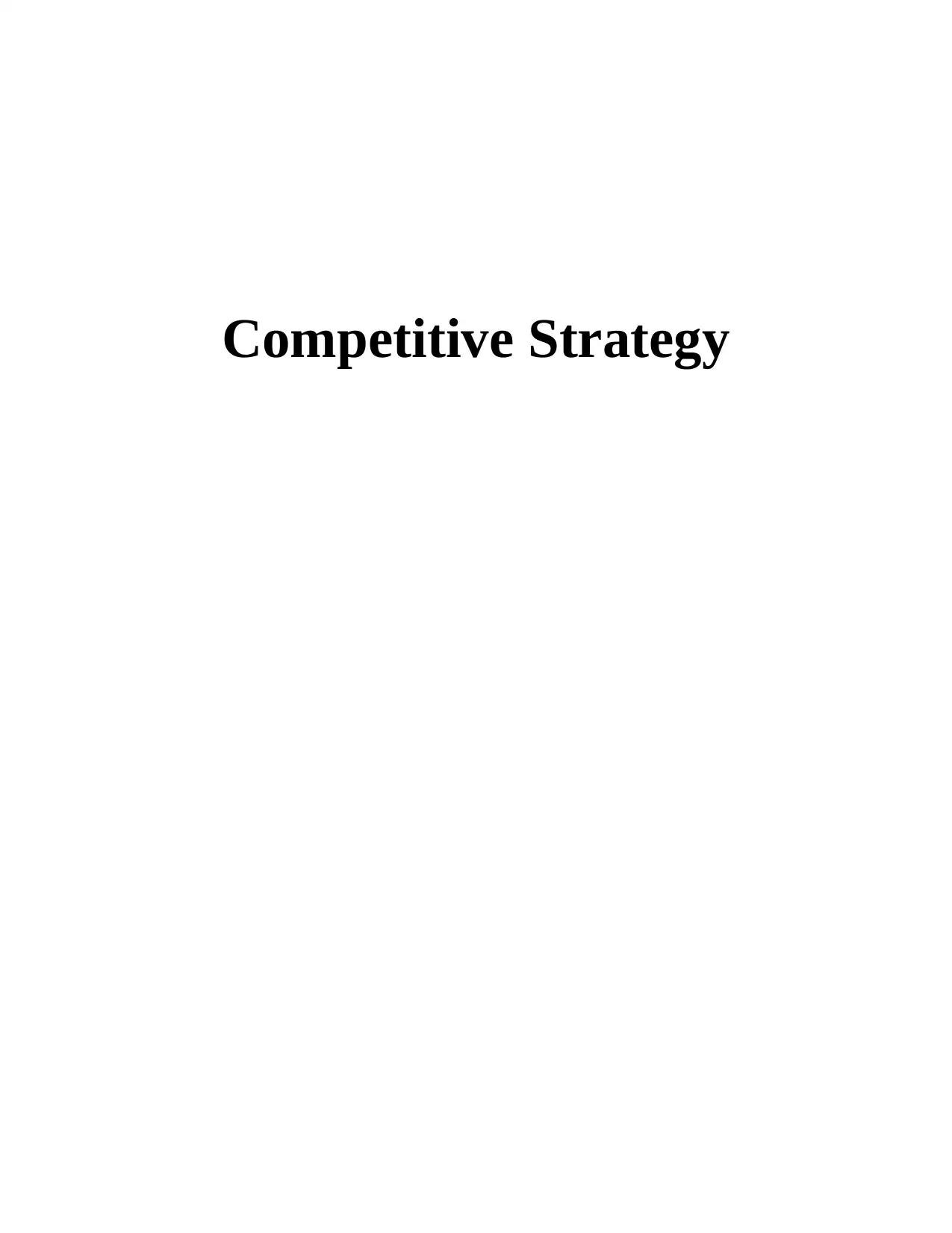
Competitive Strategy
Paraphrase This Document
Need a fresh take? Get an instant paraphrase of this document with our AI Paraphraser
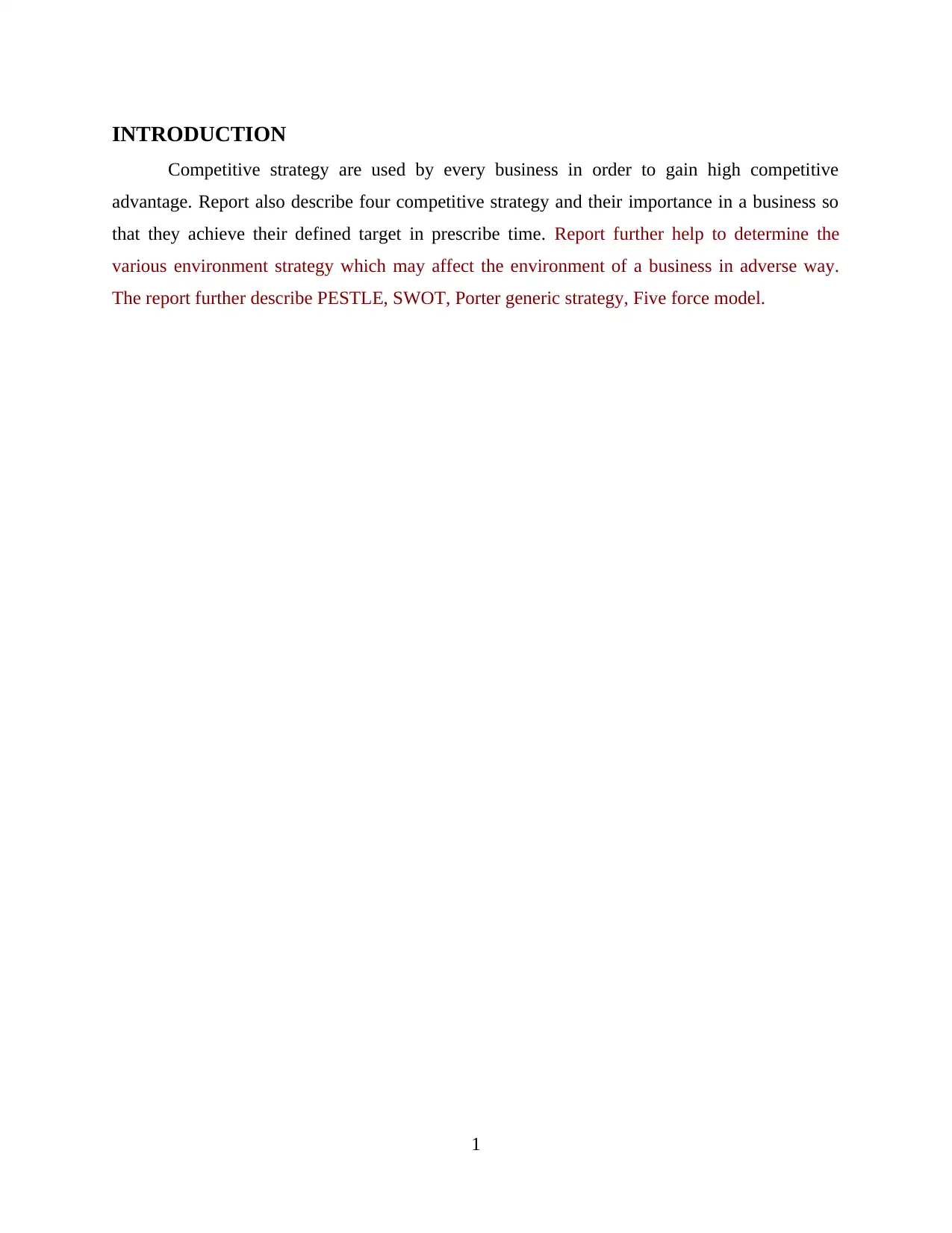
INTRODUCTION
Competitive strategy are used by every business in order to gain high competitive
advantage. Report also describe four competitive strategy and their importance in a business so
that they achieve their defined target in prescribe time. Report further help to determine the
various environment strategy which may affect the environment of a business in adverse way.
The report further describe PESTLE, SWOT, Porter generic strategy, Five force model.
1
Competitive strategy are used by every business in order to gain high competitive
advantage. Report also describe four competitive strategy and their importance in a business so
that they achieve their defined target in prescribe time. Report further help to determine the
various environment strategy which may affect the environment of a business in adverse way.
The report further describe PESTLE, SWOT, Porter generic strategy, Five force model.
1
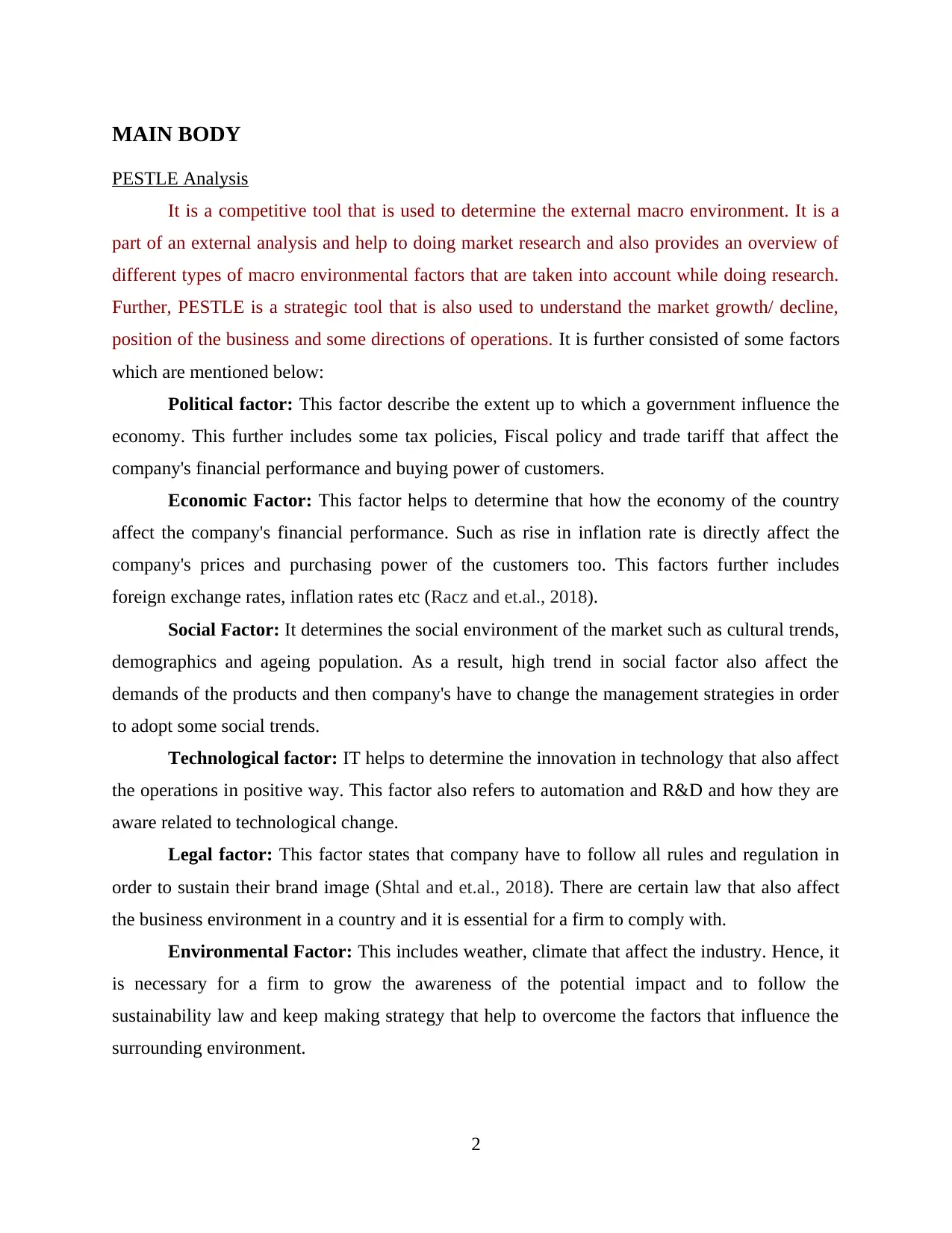
MAIN BODY
PESTLE Analysis
It is a competitive tool that is used to determine the external macro environment. It is a
part of an external analysis and help to doing market research and also provides an overview of
different types of macro environmental factors that are taken into account while doing research.
Further, PESTLE is a strategic tool that is also used to understand the market growth/ decline,
position of the business and some directions of operations. It is further consisted of some factors
which are mentioned below:
Political factor: This factor describe the extent up to which a government influence the
economy. This further includes some tax policies, Fiscal policy and trade tariff that affect the
company's financial performance and buying power of customers.
Economic Factor: This factor helps to determine that how the economy of the country
affect the company's financial performance. Such as rise in inflation rate is directly affect the
company's prices and purchasing power of the customers too. This factors further includes
foreign exchange rates, inflation rates etc (Racz and et.al., 2018).
Social Factor: It determines the social environment of the market such as cultural trends,
demographics and ageing population. As a result, high trend in social factor also affect the
demands of the products and then company's have to change the management strategies in order
to adopt some social trends.
Technological factor: IT helps to determine the innovation in technology that also affect
the operations in positive way. This factor also refers to automation and R&D and how they are
aware related to technological change.
Legal factor: This factor states that company have to follow all rules and regulation in
order to sustain their brand image (Shtal and et.al., 2018). There are certain law that also affect
the business environment in a country and it is essential for a firm to comply with.
Environmental Factor: This includes weather, climate that affect the industry. Hence, it
is necessary for a firm to grow the awareness of the potential impact and to follow the
sustainability law and keep making strategy that help to overcome the factors that influence the
surrounding environment.
2
PESTLE Analysis
It is a competitive tool that is used to determine the external macro environment. It is a
part of an external analysis and help to doing market research and also provides an overview of
different types of macro environmental factors that are taken into account while doing research.
Further, PESTLE is a strategic tool that is also used to understand the market growth/ decline,
position of the business and some directions of operations. It is further consisted of some factors
which are mentioned below:
Political factor: This factor describe the extent up to which a government influence the
economy. This further includes some tax policies, Fiscal policy and trade tariff that affect the
company's financial performance and buying power of customers.
Economic Factor: This factor helps to determine that how the economy of the country
affect the company's financial performance. Such as rise in inflation rate is directly affect the
company's prices and purchasing power of the customers too. This factors further includes
foreign exchange rates, inflation rates etc (Racz and et.al., 2018).
Social Factor: It determines the social environment of the market such as cultural trends,
demographics and ageing population. As a result, high trend in social factor also affect the
demands of the products and then company's have to change the management strategies in order
to adopt some social trends.
Technological factor: IT helps to determine the innovation in technology that also affect
the operations in positive way. This factor also refers to automation and R&D and how they are
aware related to technological change.
Legal factor: This factor states that company have to follow all rules and regulation in
order to sustain their brand image (Shtal and et.al., 2018). There are certain law that also affect
the business environment in a country and it is essential for a firm to comply with.
Environmental Factor: This includes weather, climate that affect the industry. Hence, it
is necessary for a firm to grow the awareness of the potential impact and to follow the
sustainability law and keep making strategy that help to overcome the factors that influence the
surrounding environment.
2
⊘ This is a preview!⊘
Do you want full access?
Subscribe today to unlock all pages.

Trusted by 1+ million students worldwide
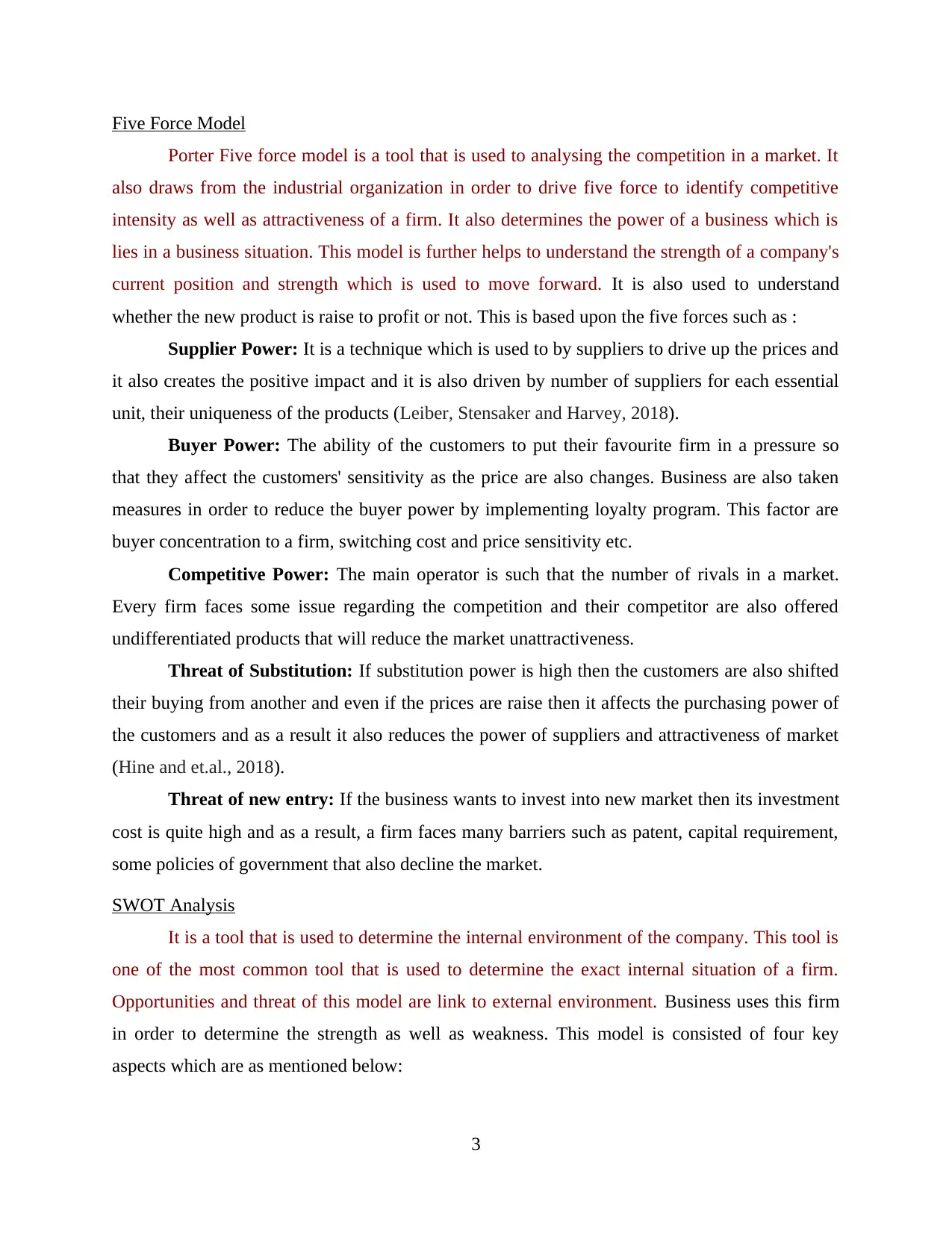
Five Force Model
Porter Five force model is a tool that is used to analysing the competition in a market. It
also draws from the industrial organization in order to drive five force to identify competitive
intensity as well as attractiveness of a firm. It also determines the power of a business which is
lies in a business situation. This model is further helps to understand the strength of a company's
current position and strength which is used to move forward. It is also used to understand
whether the new product is raise to profit or not. This is based upon the five forces such as :
Supplier Power: It is a technique which is used to by suppliers to drive up the prices and
it also creates the positive impact and it is also driven by number of suppliers for each essential
unit, their uniqueness of the products (Leiber, Stensaker and Harvey, 2018).
Buyer Power: The ability of the customers to put their favourite firm in a pressure so
that they affect the customers' sensitivity as the price are also changes. Business are also taken
measures in order to reduce the buyer power by implementing loyalty program. This factor are
buyer concentration to a firm, switching cost and price sensitivity etc.
Competitive Power: The main operator is such that the number of rivals in a market.
Every firm faces some issue regarding the competition and their competitor are also offered
undifferentiated products that will reduce the market unattractiveness.
Threat of Substitution: If substitution power is high then the customers are also shifted
their buying from another and even if the prices are raise then it affects the purchasing power of
the customers and as a result it also reduces the power of suppliers and attractiveness of market
(Hine and et.al., 2018).
Threat of new entry: If the business wants to invest into new market then its investment
cost is quite high and as a result, a firm faces many barriers such as patent, capital requirement,
some policies of government that also decline the market.
SWOT Analysis
It is a tool that is used to determine the internal environment of the company. This tool is
one of the most common tool that is used to determine the exact internal situation of a firm.
Opportunities and threat of this model are link to external environment. Business uses this firm
in order to determine the strength as well as weakness. This model is consisted of four key
aspects which are as mentioned below:
3
Porter Five force model is a tool that is used to analysing the competition in a market. It
also draws from the industrial organization in order to drive five force to identify competitive
intensity as well as attractiveness of a firm. It also determines the power of a business which is
lies in a business situation. This model is further helps to understand the strength of a company's
current position and strength which is used to move forward. It is also used to understand
whether the new product is raise to profit or not. This is based upon the five forces such as :
Supplier Power: It is a technique which is used to by suppliers to drive up the prices and
it also creates the positive impact and it is also driven by number of suppliers for each essential
unit, their uniqueness of the products (Leiber, Stensaker and Harvey, 2018).
Buyer Power: The ability of the customers to put their favourite firm in a pressure so
that they affect the customers' sensitivity as the price are also changes. Business are also taken
measures in order to reduce the buyer power by implementing loyalty program. This factor are
buyer concentration to a firm, switching cost and price sensitivity etc.
Competitive Power: The main operator is such that the number of rivals in a market.
Every firm faces some issue regarding the competition and their competitor are also offered
undifferentiated products that will reduce the market unattractiveness.
Threat of Substitution: If substitution power is high then the customers are also shifted
their buying from another and even if the prices are raise then it affects the purchasing power of
the customers and as a result it also reduces the power of suppliers and attractiveness of market
(Hine and et.al., 2018).
Threat of new entry: If the business wants to invest into new market then its investment
cost is quite high and as a result, a firm faces many barriers such as patent, capital requirement,
some policies of government that also decline the market.
SWOT Analysis
It is a tool that is used to determine the internal environment of the company. This tool is
one of the most common tool that is used to determine the exact internal situation of a firm.
Opportunities and threat of this model are link to external environment. Business uses this firm
in order to determine the strength as well as weakness. This model is consisted of four key
aspects which are as mentioned below:
3
Paraphrase This Document
Need a fresh take? Get an instant paraphrase of this document with our AI Paraphraser
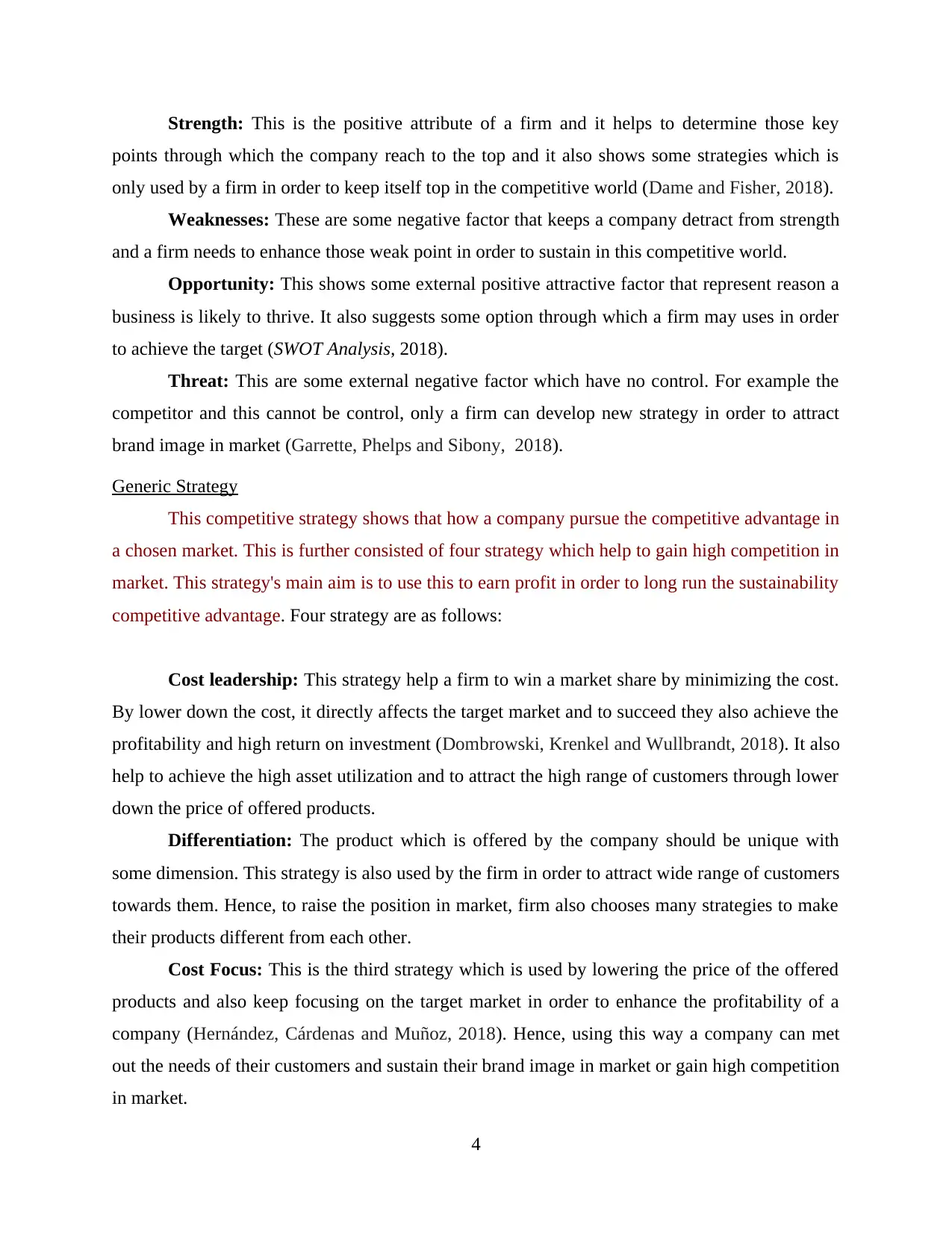
Strength: This is the positive attribute of a firm and it helps to determine those key
points through which the company reach to the top and it also shows some strategies which is
only used by a firm in order to keep itself top in the competitive world (Dame and Fisher, 2018).
Weaknesses: These are some negative factor that keeps a company detract from strength
and a firm needs to enhance those weak point in order to sustain in this competitive world.
Opportunity: This shows some external positive attractive factor that represent reason a
business is likely to thrive. It also suggests some option through which a firm may uses in order
to achieve the target (SWOT Analysis, 2018).
Threat: This are some external negative factor which have no control. For example the
competitor and this cannot be control, only a firm can develop new strategy in order to attract
brand image in market (Garrette, Phelps and Sibony, 2018).
Generic Strategy
This competitive strategy shows that how a company pursue the competitive advantage in
a chosen market. This is further consisted of four strategy which help to gain high competition in
market. This strategy's main aim is to use this to earn profit in order to long run the sustainability
competitive advantage. Four strategy are as follows:
Cost leadership: This strategy help a firm to win a market share by minimizing the cost.
By lower down the cost, it directly affects the target market and to succeed they also achieve the
profitability and high return on investment (Dombrowski, Krenkel and Wullbrandt, 2018). It also
help to achieve the high asset utilization and to attract the high range of customers through lower
down the price of offered products.
Differentiation: The product which is offered by the company should be unique with
some dimension. This strategy is also used by the firm in order to attract wide range of customers
towards them. Hence, to raise the position in market, firm also chooses many strategies to make
their products different from each other.
Cost Focus: This is the third strategy which is used by lowering the price of the offered
products and also keep focusing on the target market in order to enhance the profitability of a
company (Hernández, Cárdenas and Muñoz, 2018). Hence, using this way a company can met
out the needs of their customers and sustain their brand image in market or gain high competition
in market.
4
points through which the company reach to the top and it also shows some strategies which is
only used by a firm in order to keep itself top in the competitive world (Dame and Fisher, 2018).
Weaknesses: These are some negative factor that keeps a company detract from strength
and a firm needs to enhance those weak point in order to sustain in this competitive world.
Opportunity: This shows some external positive attractive factor that represent reason a
business is likely to thrive. It also suggests some option through which a firm may uses in order
to achieve the target (SWOT Analysis, 2018).
Threat: This are some external negative factor which have no control. For example the
competitor and this cannot be control, only a firm can develop new strategy in order to attract
brand image in market (Garrette, Phelps and Sibony, 2018).
Generic Strategy
This competitive strategy shows that how a company pursue the competitive advantage in
a chosen market. This is further consisted of four strategy which help to gain high competition in
market. This strategy's main aim is to use this to earn profit in order to long run the sustainability
competitive advantage. Four strategy are as follows:
Cost leadership: This strategy help a firm to win a market share by minimizing the cost.
By lower down the cost, it directly affects the target market and to succeed they also achieve the
profitability and high return on investment (Dombrowski, Krenkel and Wullbrandt, 2018). It also
help to achieve the high asset utilization and to attract the high range of customers through lower
down the price of offered products.
Differentiation: The product which is offered by the company should be unique with
some dimension. This strategy is also used by the firm in order to attract wide range of customers
towards them. Hence, to raise the position in market, firm also chooses many strategies to make
their products different from each other.
Cost Focus: This is the third strategy which is used by lowering the price of the offered
products and also keep focusing on the target market in order to enhance the profitability of a
company (Hernández, Cárdenas and Muñoz, 2018). Hence, using this way a company can met
out the needs of their customers and sustain their brand image in market or gain high competition
in market.
4
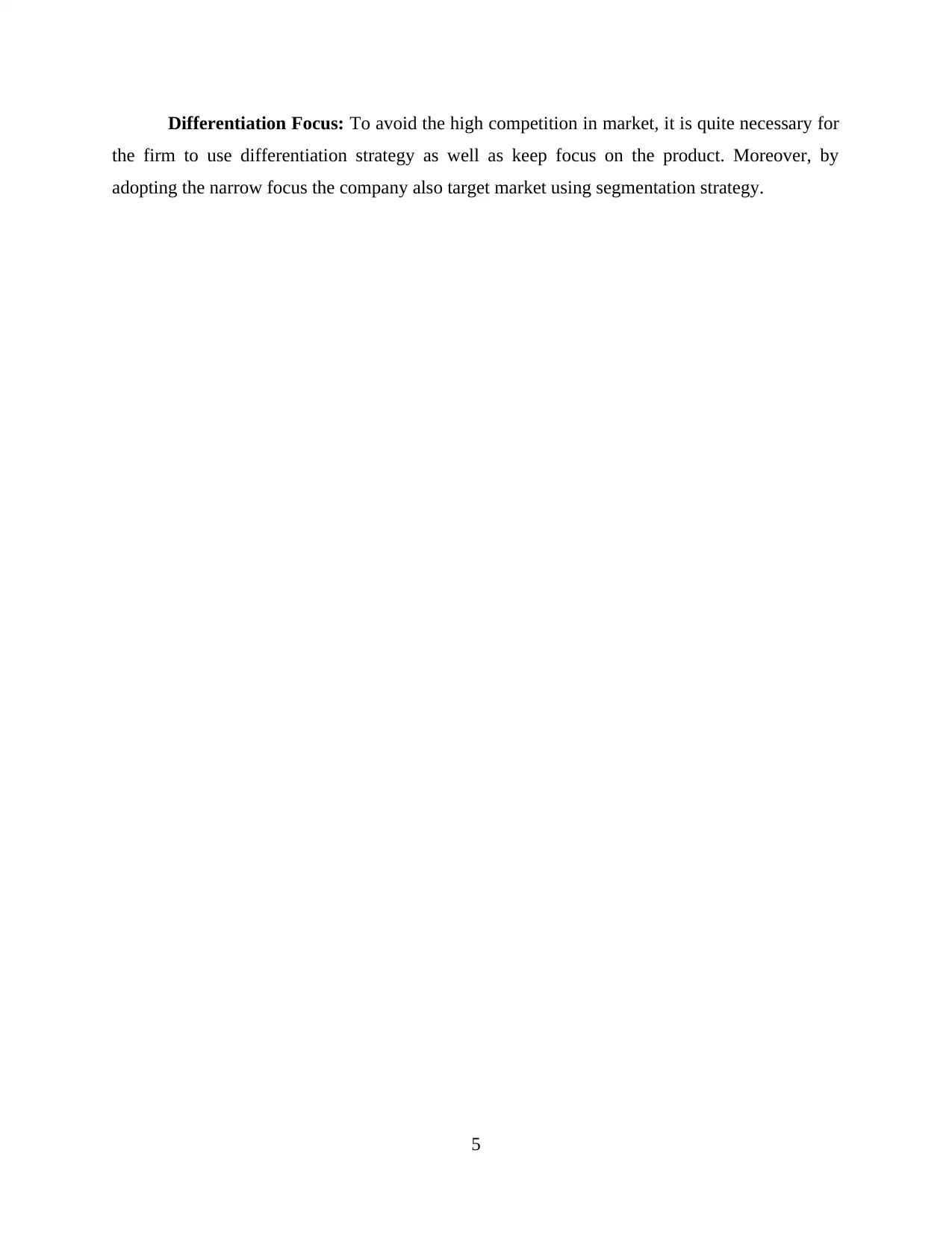
Differentiation Focus: To avoid the high competition in market, it is quite necessary for
the firm to use differentiation strategy as well as keep focus on the product. Moreover, by
adopting the narrow focus the company also target market using segmentation strategy.
5
the firm to use differentiation strategy as well as keep focus on the product. Moreover, by
adopting the narrow focus the company also target market using segmentation strategy.
5
⊘ This is a preview!⊘
Do you want full access?
Subscribe today to unlock all pages.

Trusted by 1+ million students worldwide
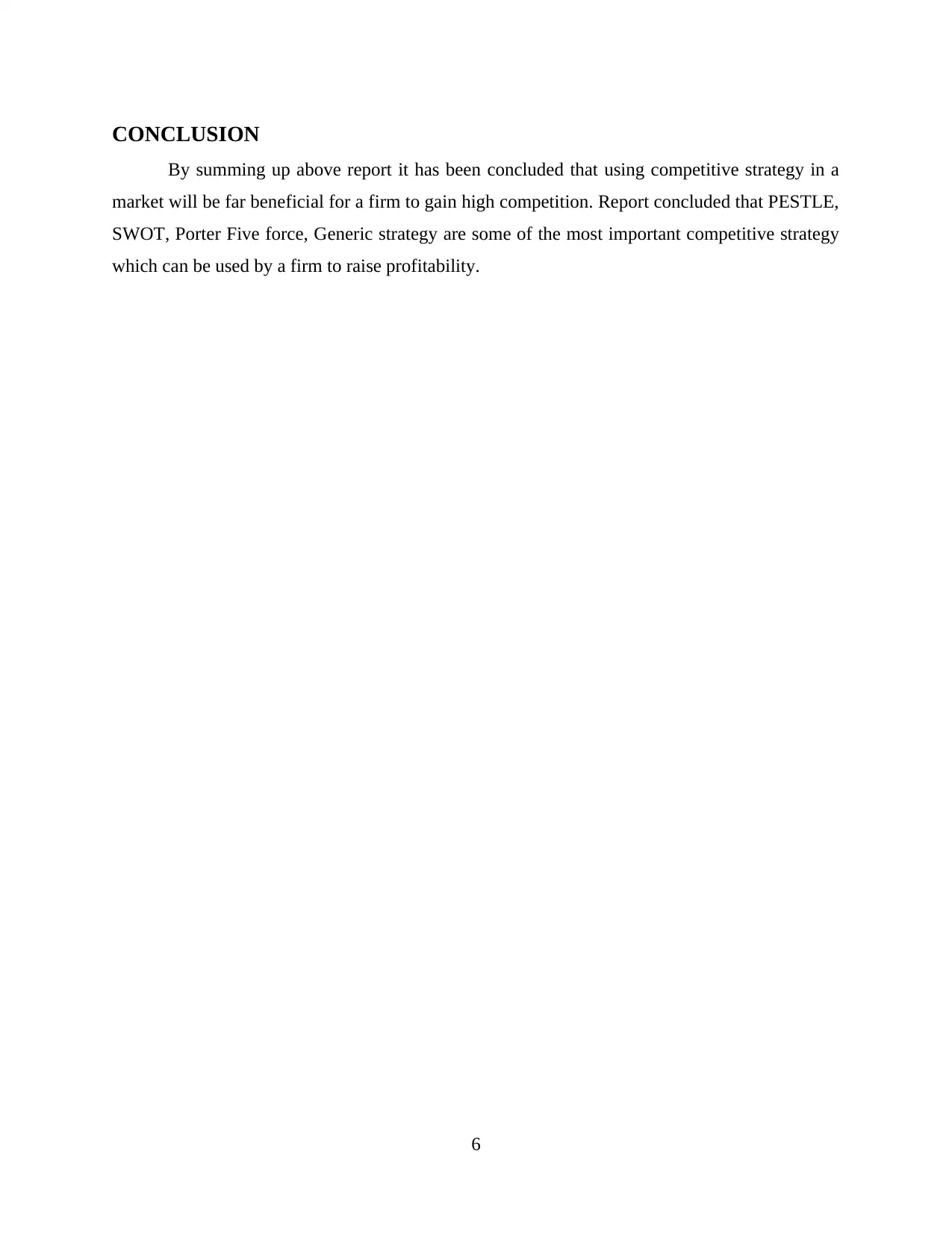
CONCLUSION
By summing up above report it has been concluded that using competitive strategy in a
market will be far beneficial for a firm to gain high competition. Report concluded that PESTLE,
SWOT, Porter Five force, Generic strategy are some of the most important competitive strategy
which can be used by a firm to raise profitability.
6
By summing up above report it has been concluded that using competitive strategy in a
market will be far beneficial for a firm to gain high competition. Report concluded that PESTLE,
SWOT, Porter Five force, Generic strategy are some of the most important competitive strategy
which can be used by a firm to raise profitability.
6
Paraphrase This Document
Need a fresh take? Get an instant paraphrase of this document with our AI Paraphraser
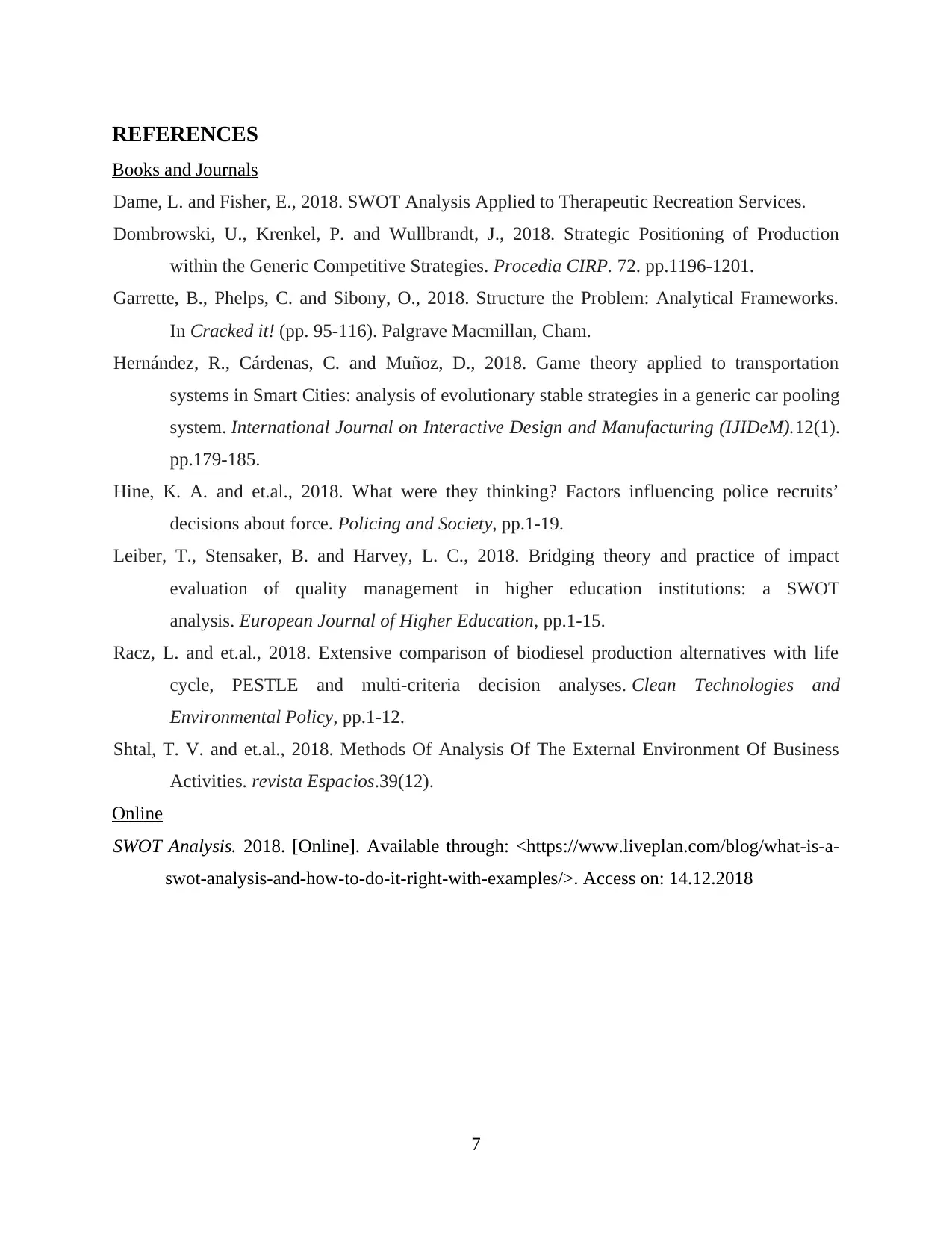
REFERENCES
Books and Journals
Dame, L. and Fisher, E., 2018. SWOT Analysis Applied to Therapeutic Recreation Services.
Dombrowski, U., Krenkel, P. and Wullbrandt, J., 2018. Strategic Positioning of Production
within the Generic Competitive Strategies. Procedia CIRP. 72. pp.1196-1201.
Garrette, B., Phelps, C. and Sibony, O., 2018. Structure the Problem: Analytical Frameworks.
In Cracked it! (pp. 95-116). Palgrave Macmillan, Cham.
Hernández, R., Cárdenas, C. and Muñoz, D., 2018. Game theory applied to transportation
systems in Smart Cities: analysis of evolutionary stable strategies in a generic car pooling
system. International Journal on Interactive Design and Manufacturing (IJIDeM).12(1).
pp.179-185.
Hine, K. A. and et.al., 2018. What were they thinking? Factors influencing police recruits’
decisions about force. Policing and Society, pp.1-19.
Leiber, T., Stensaker, B. and Harvey, L. C., 2018. Bridging theory and practice of impact
evaluation of quality management in higher education institutions: a SWOT
analysis. European Journal of Higher Education, pp.1-15.
Racz, L. and et.al., 2018. Extensive comparison of biodiesel production alternatives with life
cycle, PESTLE and multi-criteria decision analyses. Clean Technologies and
Environmental Policy, pp.1-12.
Shtal, T. V. and et.al., 2018. Methods Of Analysis Of The External Environment Of Business
Activities. revista Espacios.39(12).
Online
SWOT Analysis. 2018. [Online]. Available through: <https://www.liveplan.com/blog/what-is-a-
swot-analysis-and-how-to-do-it-right-with-examples/>. Access on: 14.12.2018
7
Books and Journals
Dame, L. and Fisher, E., 2018. SWOT Analysis Applied to Therapeutic Recreation Services.
Dombrowski, U., Krenkel, P. and Wullbrandt, J., 2018. Strategic Positioning of Production
within the Generic Competitive Strategies. Procedia CIRP. 72. pp.1196-1201.
Garrette, B., Phelps, C. and Sibony, O., 2018. Structure the Problem: Analytical Frameworks.
In Cracked it! (pp. 95-116). Palgrave Macmillan, Cham.
Hernández, R., Cárdenas, C. and Muñoz, D., 2018. Game theory applied to transportation
systems in Smart Cities: analysis of evolutionary stable strategies in a generic car pooling
system. International Journal on Interactive Design and Manufacturing (IJIDeM).12(1).
pp.179-185.
Hine, K. A. and et.al., 2018. What were they thinking? Factors influencing police recruits’
decisions about force. Policing and Society, pp.1-19.
Leiber, T., Stensaker, B. and Harvey, L. C., 2018. Bridging theory and practice of impact
evaluation of quality management in higher education institutions: a SWOT
analysis. European Journal of Higher Education, pp.1-15.
Racz, L. and et.al., 2018. Extensive comparison of biodiesel production alternatives with life
cycle, PESTLE and multi-criteria decision analyses. Clean Technologies and
Environmental Policy, pp.1-12.
Shtal, T. V. and et.al., 2018. Methods Of Analysis Of The External Environment Of Business
Activities. revista Espacios.39(12).
Online
SWOT Analysis. 2018. [Online]. Available through: <https://www.liveplan.com/blog/what-is-a-
swot-analysis-and-how-to-do-it-right-with-examples/>. Access on: 14.12.2018
7
1 out of 8
Related Documents
Your All-in-One AI-Powered Toolkit for Academic Success.
+13062052269
info@desklib.com
Available 24*7 on WhatsApp / Email
![[object Object]](/_next/static/media/star-bottom.7253800d.svg)
Unlock your academic potential
Copyright © 2020–2025 A2Z Services. All Rights Reserved. Developed and managed by ZUCOL.




